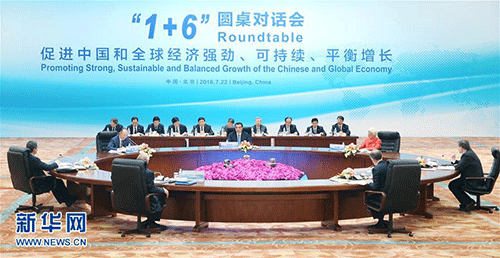
People’s Republic of China



On the morning of July 22, 2016, Premier Li Keqiang held the “1+6” round table dialogue with President Jim Yong Kim of the World Bank, Managing Director Christine Lagarde of the International Monetary Fund, Director-General Roberto Azevedo of the World Trade Organization, Director-General Guy Ryde of the International Labor Organization, Secretary-General Angel Gurría of the Organization for Economic Cooperation and Development and Chairman Mark Carney of the Financial Stability Board at the Fanghua Garden of the Diaoyutai State Guesthouse, and made an in-depth exchange on the topic of “New Growth Drivers Amidst China’s Economic Transformation” in Session II of the dialogue.
Li Keqiang introduced the current economic situation of China. He said that facing many tough difficulties and challenges at home and abroad as well as the downward economic pressure, the Chinese government has made efforts to stabilize the macro policy orientation, focus on pushing forward the structural reform, especially the supply-side structural reform, vigorously develop new economy, and foster new growth drivers while transforming and upgrading traditional ones. With all these efforts, Chinese economy has shown a pattern of steady growth interwoven with accelerated transformation and upgrading, and China has remained one of the fastest growing major economies, and made positive gains in the transformation and upgrading of the economic structure. Over the past three-plus years, the proportion of the service sector in GDP increased 8.6 percentage points and the contribution of the final consumption to GDP increased by 16.9 percentage points. The rapid development of new economy and the like has promoted the transformation and upgrading as well as energy release of the traditional industries and vigorously boosted expansion of employment, with the average annual increase of urban employment kept above 13 million persons in the past three years.
Li Keqiang noted that Chinese economy has ensured both stability and progress, displaying a situation of rising increment, stock adjustment and structure transformation. All of these fundamentally rely on the reform and innovation. We have made tremendous efforts to streamline administration, delegate power, enhance regulation where necessary, provide better services and advance other reforms. Thanks to the strategy of innovation-driven development we implemented, mass entrepreneurship and mass innovation are booming, and new business forms like crowd innovation economy and sharing economy are thriving, providing powerful support to economic growth, structural transformation and upgrading and employment expansion. We will bring into further play China’s advantages in abundant resources of labor and talents, deeply advance the new type of urbanization, and provide multiple supports to the enhancement of new growth drivers by comprehensively deepening reforms and expanding the opening-up. All parties are welcome to offer further advice and suggestions about China’s economy, especially in realization of driver transformation and structural transformation.
Li Keqiang stressed that China will maintain continuity, stability and pertinence of its macroeconomic policy, adhere to implementing the proactive fiscal policy and the prudent monetary policy, and enhance discretionary macro-regulation and undertake preemptive adjustment and fine-tuning as the changing dynamics require. China will expand the aggregate demand as appropriate, focus on supply-side structural reform and take multi-pronged steps to bring down the leverage ratio of non-financial enterprises in an active yet prudent manner. While resolving the excess capacity, China will make efforts to protect the rights and interests of workers and facilitate re-employment by promoting mass entrepreneurship and innovation and the like. China now enjoys steady economic performance, a surplus in its international balance of payments, sufficient foreign exchange reserve as well as a sturdy fiscal and financial system. There is no foundation for continued depreciation of RMB. We will unswervingly stay on the course of market-oriented reform of the exchange rate, bring into better play the decisive role of the market, and keep the exchange rate of RMB generally stable at a reasonable and balanced level.
Heads of the participating international economic and financial institutions said that the measures of the structural reform in China’s economy prove to be fruitful, with economic growth more resilient and more sustainable. The prophecy of “hard landing” of Chinese economy will no longer be bought. China’s investments in the development of human resource and the field of innovation are impressive, with the development of e-commerce, digital finance and other emerging industries leading the world and the development of new economy and new growth drivers facing great opportunities. International economic and financial institutions are willing to further enhance coordination and cooperation with China and provide support to China in promoting reforms, expanding the opening-up, improving the social security system, guarding against financial risks and other aspects.


